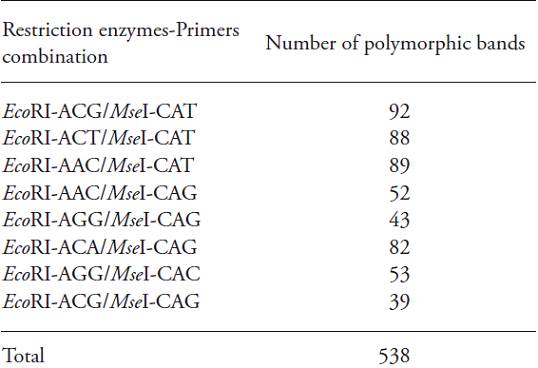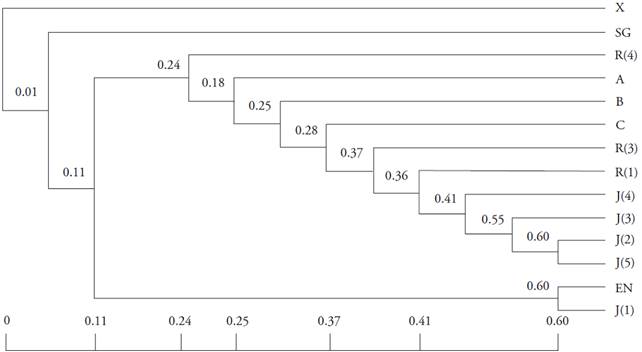Introduction
Stenocereus pruinosus (Otto) Buxbaum is a columnar cactus known as pitaya de mayo, mainly located in the semi-arid region of the Tehuacan valley at the Center of Mexico (Bravo-Hollis, 1978; Parra et al., 2012). This species has gone through a domestication process since approximately 8000 years ago (Smith, 1967; Luna-Morales and Aguirre, 2001), basically conducted by big sweet fruits, with thin epidermis, few thorns and different colored pulps selection (Luna-Morales and Aguirre, 2001; Rosales-Bustamante et al., 2009; Parra et al., 2012). This process has generated more than 30 varieties with different commercially attractive features (Luna-Morales, 2007; Rosales-Bustamante et al., 2009).
Stenocereus pruinosus is found in wild populations, in agro-forestry systems and grows in orchards (Parra et al., 2010; 2012). Within the orchards the most common pattern to reproduce and increase production is by the cutting method, this produces plant clones with desirable characteristics; therefore plants coming from common original stems may be considered genetic replicates (Rosales-Bustamante et al., 2009; Carrillo-Ángeles and Mandujano, 2011). According to Rozenfeld et al. (2007), almost no genetic variation is produced by this method, and each individual becomes a ramet of the original one, which is common in natural cacti populations (Clark-Tapia et al., 2005a; 2005b).
According to Luna-Morales (2004), an evidence of this species’ domestication is an inter-specific hybrid, between S. pruinosus and S. stellatus (Pfeiffer) Ricobono, called San Gabriel by growers in the Mixteca Baja region (Nortwestern Oaxaca and Southeastern Puebla). This hybrid was obtained by the Mixtecos by means of its handling and selection from in situ grown populations and ex situ later in orchards near this region. Besides, this hybrid presents two marked fructification seasons in the year and each one coincides with the parental species’ fructification.
The high morphological and genetic variability among wild and cultivated populations is due to the producing species’ artificial selection (Parra et al., 2008; 2010; 2012). However, genetic relationships among different clonal orchards within the agricultural production are not studied. For this reason, the objective of this experiment was to analyze S. pruinosus genetic diversity and genetic relationships by means of AFLP, in Puebla and Oaxaca, clonal orchards, including in this study S. stellatus, a closely related species as outgroup, and their putative hybrid San Gabriel. The hypothesis was that S. pruinosus accessions from the same variety are genetically similar, independently from their region of provenance.
Materials and Methods
This study was carried out with 12 accessions of S. pruinosus using individual stems of the varieties Ceniza (C), Roja (R), Amarilla (A), Burra (B), Espina Negra (EN) and Jarro (J); the hybrid San Gabriel (SG) and S. stellatus (X), as out-group, collected from clonal orchards of Oaxaca and Puebla (Table 1). DNA extraction was made from 20 mg of stem chlorophyllic parenchyma (the amount of used DNA avoids kit membrane saturation with the cactus mucilage), using the DNeasy® Plant Mini Kit (Qiagen). AFLP technique (Vos et al., 1995) was out with the AFLP® Plant Mapping Kit (Applied Biosystems), according to its protocol and testing 32 combinations of primers. DNA fragments were detected by means of an automatic ABI PRISM® 3130XL Genetic Analyzer sequencer.
Electropherograms were analyzed through the Gene Marker® V.2 (The Biological Friendly Software SoftGenetics) program. Similarity coefficients were estimated from the generated binary matrix by means of the Nei and Li index (1979) with the Free Tree v 0.9.1.50 program (Pavlíček et al., 1999). A 1000 repetition re-sampling (bootstrap) was carried and a consensus tree was obtained (Hampl et al., 2001). Besides data were grouped by the Unweighted Pair-Group Method Arithmetic Average (UPGMA) and a dendrogram was built by using the Tree View v.1.6.6 program (Page, 1996).
Results and Discussion
From the 32 tested AFLP primer combinations, we chose those eight combinations that amplified the largest number of fragments. A total of 538 bands was obtained by using those markers (Table 2). The number of polymorphisms from each of the primer combinations was very high in relation to the figures reported for other Cactaceae, as Opuntia pilifera and Cereus spp. (Nilsen et al., 2005; Faria-Tavares et al., 2013), and other species, as Passiflora edulis (Ponciano-Samayoa and Lacán-de León, 2012).
Table 2: Primers combinations tested with EcoR1 and Mse1, and number of polymorphic bands obtained for each combination.

All the S. pruinosus varieties were grouped with a similarity index from 0.24 to 0.60 in the UPGMA dendrogram (Figure 1). The S. pruinosus accessions were separated into two sub-groups; the first one belongs to samples from Oaxaca and the second one to samples from Puebla. Besides, very few bands amplified in the case of S. stellatus from the eight used AFLP combinations. This provided a similarity index of 0.01 with respect to the S. pruinosus accessions, even though they are closely related species, whereas the San Gabriel hybrid showed a similarity index of 0.11 in relation to the pitaya group (Figure 1).

Figure 1: A UPGMA dendrogram representing the relationships between 12 S. pruinosus accessions, S. stellatus and the San Gabriel hybrid. The genetic similarity among individuals is defined by the horizontal branches’ length. The numbers at the bifurcation points indicate the similarity between accessions, based on Nei-Li similarity coefficient calculated from AFLP profiles derived from eight primer combinations.
The similarity values show that all the studied accessions are genetically different, including those belonging to the same variety, such as pitaya Roja and Jarro, which suggests that all the analyzed clonal orchards (irrespective of the variety) have diverse origins. This result coincides with that of Parra et al. (2010), who reported that there is a high genetic variability in S. pruinosus populations, particularly in those handled by artificial selection (Casas and Parra, 2007; Parra et al., 2008 and 2012). However, our result opposes to other reported species of the same genus, such as S. stellatus (Casas et al., 2006), S. gummosus, S. eruca and S. thurberi (Hamrick et al., 2002; Clark-Tapia and Molina-Freaner, 2003; Clark-Tapia et al., 2005a; Lozano et al., 2015).
Orchards in Puebla and Oaxaca, where individuals were collected, presented different biotic and abiotic factors, which suggests that genetic variability is a result of both adaptation to environmental differences in the collecting sites (Morales-Nieto et al., 2006), and the vegetative handling by growers to determine the origin of the sprouts, which contributes to maintain or to increase the diversity in orchards (Casas et al., 1999; Casas y Parra, 2007; Parra et al., 2012). Nevertheless, Clark-Tapia et al., (2005a; 2005b) report that no intra-population variation is present in the closely related species Stenocereus eruca.
The large genetic distance value found between different pitaya accessions from the clonal orchards is probably due to the traditional handling performed through time and to the surrounding environmental characteristics. Finally, the successful primers combinations used in our study, and the AFLP technique itself, might help to perform studies of genetic diversity on S. pruinosus and closely related species.
Conclusions
A large genetic diversity was found between Stenocereus pruinosus cultivars. Opposite to what was expected, S. pruinosus accessions from the same variety showed large genetic distance, despite their vegetative propagation. They were grouped according to the region of provenance, regardless of the variety to which they belong.











 text in
text in 



